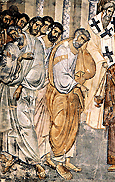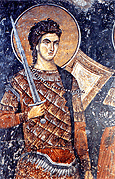 |
|
 |
13th century: Painting
 he break-up of the Empire after the Fourth Crusade (1204) also had an effect on the artistic activity of the period.
he break-up of the Empire after the Fourth Crusade (1204) also had an effect on the artistic activity of the period.
 The establishment of autonomous rival states resulted in the creation of new centres, where the arts would eventually develop. The Greek, Serb and Bulgarian rulers, who saw themselves as the legal heirs of the Byzantine throne, developed remarkable building programmes and financed the decoration of the churches with frescoes.
On the other hand, Constantinople, once the artistic and intellectual centre of the Empire, had fallen into the hands of the Latins and the uniformity of style that had characterised the painting of the previous period of the
Komnenoi
was lost. The painting of the 13th century was now characterised by new tendencies, which evolved from the progressive style of the end of the 12th century, but which also show a conservative return to
Late Komnenian
art.
The establishment of autonomous rival states resulted in the creation of new centres, where the arts would eventually develop. The Greek, Serb and Bulgarian rulers, who saw themselves as the legal heirs of the Byzantine throne, developed remarkable building programmes and financed the decoration of the churches with frescoes.
On the other hand, Constantinople, once the artistic and intellectual centre of the Empire, had fallen into the hands of the Latins and the uniformity of style that had characterised the painting of the previous period of the
Komnenoi
was lost. The painting of the 13th century was now characterised by new tendencies, which evolved from the progressive style of the end of the 12th century, but which also show a conservative return to
Late Komnenian
art.
 After the recovery of the capital in 1261 the picture gradually changes. The first phase of Palaiologan painting, which lasts until approximately 1300, is characterised by the marked revival of classical standards. The harmony and the monumental scale of the figures, which recall ancient statues, the endeavour to render space and to express the spiritual and inner nature of the figure represented are the main characteristics of this painting, which scholars call the "first Palaiologan style". Towards the end of the century this tendency was to reach its apex, placing such emphasis on the rendering of the volume of the drapery and the figures that it was named "volume" or "heavy" style. The wide dissemination of this manner of painting throughout the Empire and its effect on the provincial and the Latin-held areas, resulted in a stylistic uniformity in art, most probably associated with the rebirth of the large artistic centre of the Empire, Constantinople, and the consequent diffusion of the new currents and aesthetic trends.
After the recovery of the capital in 1261 the picture gradually changes. The first phase of Palaiologan painting, which lasts until approximately 1300, is characterised by the marked revival of classical standards. The harmony and the monumental scale of the figures, which recall ancient statues, the endeavour to render space and to express the spiritual and inner nature of the figure represented are the main characteristics of this painting, which scholars call the "first Palaiologan style". Towards the end of the century this tendency was to reach its apex, placing such emphasis on the rendering of the volume of the drapery and the figures that it was named "volume" or "heavy" style. The wide dissemination of this manner of painting throughout the Empire and its effect on the provincial and the Latin-held areas, resulted in a stylistic uniformity in art, most probably associated with the rebirth of the large artistic centre of the Empire, Constantinople, and the consequent diffusion of the new currents and aesthetic trends.
The examination of typical examples of wall painting ensembles will allow us to follow the evolution of art during the 13th century, that is from 1204 until the recovery of Constantinople, and subsequently until about 1300.
See also : Stylistic Tendencies at the end of the 12th c.
|